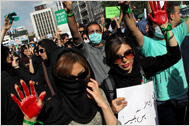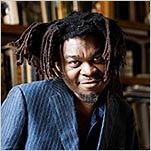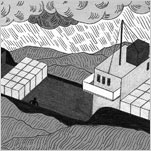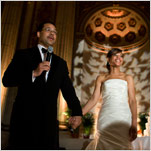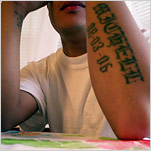TEHRAN — Iranians angry at the results of last week’s election pushed their protest forward on Wednesday, from tens of thousands who again flooded the streets here to six soccer players on the national team who wore opposition green wristbands at a World Cup qualifying game.
Where Will the Power Lie in Iran?
 What do the mass protests mean for American interests?
What do the mass protests mean for American interests?
But there were signs of an intensified crackdown: The government worked on many fronts to shield the outside world’s view of the unrest, banning coverage of the demonstrations, arresting journalists, threatening bloggers and trying to block Web sites like Facebook and Twitter, which have become vital outlets for information about the rising confrontation here.
The senior prosecutor in the central province of Isfahan, where there have also been tense demonstrations, went so far as to say protesters could be executed under Islamic law.
As nations around the world urged Iran’s leadership to exercise restraint, Mir Hussein Moussavi, the opposition presidential candidate who the government said finished second, and one of Iran’s chief reformers, Mohammad Khatami, issued a joint letter urging an end to violence and arrests.
“We ask you to take all the necessary measures to put an end to today’s worrying situation, to stop the violent actions against people and to free those arrested,” they wrote in a letter on Mr. Moussavi’s Web site.
Mr. Moussavi also sought to continue the momentum of public protest, calling for a day of mourning on Thursday for at least seven people killed in the demonstrations.
The crisis — the gravest since the Islamic Revolution in 1979 — erupted after Iran’s Interior Ministry declared that the moderate Mr. Moussavi was defeated by the conservative incumbent, Mahmoud Ahmadinejad, in Friday’s election by 63 percent to 34 percent. Mr. Moussavi, the demonstrators who represent a cross section of Iranian society and part of the clerical establishment have called the official results a fraud.
With the nation’s ruling class apparently divided by the results, the hard-liners in charge sought to portray the unrest as the work of outsiders. The powerful Revolutionary Guard said it had taken action against “deviant news sites” financed by American and Canadian companies.
The Foreign Ministry, meantime, summoned the Swiss ambassador, who represents American interests in Tehran, in protest of what it called “meddling” by the United States into its affairs because of statements by American officials on Iran’s elections. It also summoned the Canadian chargé d’affaires over the same accusations. Several other European ambassadors were summoned Tuesday.
America and Iran broke off diplomatic relations after the 1979 revolution.
No apparent ground was gained Wednesday in reaching a negotiated solution.
This week, Iran’s supreme religious leader, Ayatollah Ali Khamenei, who has the final word on state matters and who certified Mr. Ahmadinejad’s re-election, apparently made two concessions to the protests, ordering an investigation into the election and calling for a partial recount.
But Mr. Moussavi and the protesters are rejecting anything less than new elections.
“It is a very complicated situation,” said Abbass Abdi, a political scientist in Tehran. “People feel humiliated because they came and voted in large numbers. On the other hand, it is very difficult for the establishment to admit fraud because its legitimacy would go under question.
“There is no legal solution to this dilemma and, we need a solution that neither side would lose face.”
For the third day in a row, supporters of Mr. Moussavi massed in silence, from Hafteh Tir Square, with photographs and samizdat video showing a sea of people at least tens of thousands strong. Many protesters wore black to honor those slain in recent days, a witness said. Some carried flowers and wore green ribbons to show their support for Mr. Moussavi.
“We are becoming stronger,” said Abolfazl, 36, a cab driver. “The only way we can win is to stick together and keep coming back.”
Mostafa, 26, a businessman, who had gone to the rally on the back of a friend’s motorcycle, said he did not fear the violent clashes that killed protesters. “The student protests failed because people left the students alone,” he said, referring to the student protests in 1999 and 2003. “This time they cannot defeat us because everybody has joined.”
Surprise support for the protesters came from members of Iran’s soccer team, with several wearing the bright green ribbons, now the signature for Mr. Moussavi’s supporters, during a game with South Korea.
The national football team is controlled by the government, and their defiance demonstrated the deepening divide.
It was unclear whether clashes erupted between security forces and protesters later Wednesday evening, as has happened during other protests this week.
The government had announced that seven people were killed Monday and 15 others were injured after a Basij militia, loyal to Mr. Ahmadinejad, opened fire on people. On Wednesday, a student group, the Office for Consolidating Unity, said in a statement on its Web site that five students were killed in an attack on a Tehran University dormitory and two other students were killed in a separate attack at the dormitory in the southern city of Shiraz.
Iran’s Interior Ministry on Thursday ordered an investigation into the episode at Tehran University, which has been widely denounced inside Iran.
Meanwhile, the government expanded its crackdown with more arrests and pressure against journalists to limit coverage of the protests.
Saeed Leylaz, an economist and political analyst, was arrested Wednesday at his home. Mohammad Reza Jalaipour, a sociologist and university professor, was also arrested. Reporters Without Borders said that at least 11 Iranian journalists had been arrested.
Because of continued intimidation and pressure on journalists, at least one newspaper, Khabar, said Wednesday that it would stop publishing. A representative from the office of the prosecutor general in Tehran on Friday began screening newspapers before publication to block what it called “provocative” material.
In an effort that appeared to limit reporters’ access, foreign news outlets were warned by the Ministry of Culture not to “participate in or cover” the rallies because the ministry said it “had received specific threats against reporters.” One photographer, Amin Kiani, was stabbed at a protest on Tuesday. The ministry expanded its restriction on Wednesday to covering any news conferences linked to Mr. Moussavi.
News agencies reported that Mohammadreza Habibi, the senior prosecutor in the central province of Isfahan, had warned demonstrators that they could be executed under Islamic law.
“We warn the few elements controlled by foreigners who try to disrupt domestic security by inciting individuals to destroy and to commit arson that the Islamic penal code for such individuals waging war against God is execution,” Mr. Habibi said, according to the Fars news agency.





